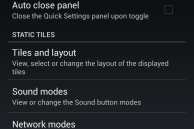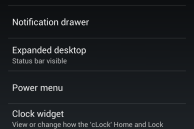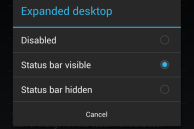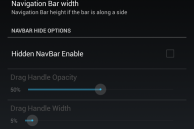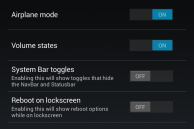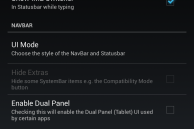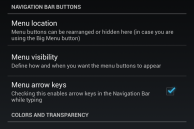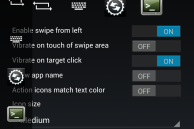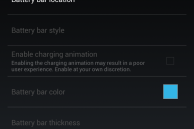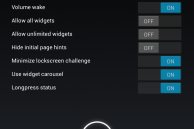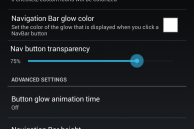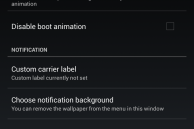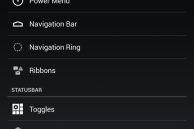 CyanogenMod is undoubtedly the most popular AOSP based custom ROM. However, due to its popularity, and the sheer number of devices that the team now supports, they have to think thousands of time before adding a new feature. While CyanogenMod was earlier known for its customization options, it is no longer the most customizable AOSP based custom ROM out there.
CyanogenMod is undoubtedly the most popular AOSP based custom ROM. However, due to its popularity, and the sheer number of devices that the team now supports, they have to think thousands of time before adding a new feature. While CyanogenMod was earlier known for its customization options, it is no longer the most customizable AOSP based custom ROM out there.
That crown is now with the AOKP ROM, which is currently used by more than a million users worldwide AOKP ROM was initially released by Roman Birg — soon to be a college graduate — when Google and Samsung released the Galaxy Nexus. The ROM soon became a favorite among the Galaxy Nexus community because of the sheer number of customization options it offered. Thanks to its popularity, the ROM was ported to other devices.
When I initially got my Nexus 4, I gave both CyanogenMod 10.1 and AOKP ROM a try on the phone. While CM felt like home, I found AOKP to lack some basic features (e.g. Vibration when a call is picked up), which were a deal breaker for me. With time though, things have changed. AOKP ROM now packs so many customization options that you will literally grow tired of playing around with them.
So what exactly does AOKP offer over CM10.1? If AOKP is so customizable, why is CM still so popular? Before we jump to comparing the features of both the ROMs, I want to provide some general information about the ROMs.
- The CyanogenMod team now aims to offer an experience that is as close to stock as possible, with some must-have tweaks. Consider CM to be stock Android on steroids, and AOKP to be a version of Android OS, where you can literally customize everything.
- AOKP uses the CyanogenMod device tree as a base to support a variety of devices. This does not mean that the team simply kangs features from the CyanogenMod Github. They very well add tons of features and tweaks, written completely from scratch by them, which are then in some cases even added by the CyanogenMod team to their ROM.
- Steve Kondik, CyanogenMod’s founder, used to work for Samsung but his work was completely unrelated to that of CM. As of now, he is working for an undisclosed company.
- CyanogenMod, just yesterday, crossed the 5 million-device installation mark, while AOKP crossed the 1 million-installation mark sometime earlier this year.
- The CyanogenMod team has an overall much more professional approach towards the ROM and their work compared to the AOKP team. This is mainly due to the fact that CM is much older, bigger and popular than the AOKP team. The AOKP team has made much improvements in this matter, especially with their stunning new website that they unveiled recently.
AOKP vs. CyanogenMod 10.1
Similarities between both the ROMs
- Both are based on the latest version of Android
- The ability to customize Quick Settings
- T9 Dialer with Call Statistics
- Stock AOSP browser
- Stock Messaging App with expandable notifications
- LED Notification Control (Like Light Flow)
- Theme Chooser
- Custom Brightness control
- Volume Rocker Wake
- Volume Rocker Music Control
- Ability to disable IME switcher
- Battery % in the status bar
- Advanced Sound panel
- Advanced Power Menu
- Expanded Desktop mode
- Improved Camera app with features like voice control
- Quiet Hours
- Recents RAM Bar
- Notification bar widgets
- Quick Launch Shortcuts
- Lock Screen Shortcuts
- The ability to always keep lock screen widgets in maximized states
- Vibration when a call is picked/on call waiting/call is disconnected
- Pie Controls
- cLock Widget Options
- Quick Settings Customization Option
- Options under System
- Options under the Developer Sub-menu
- Expanded Desktop mode options
CyanogenMod 10.1 Pros
- Inbuilt OTA updater (Not Delta though)
- Stock Android with just the right amount of customizable options to attract new users
- Comes pre-installed with a beautiful lock screen widget – cLock
- In-built Profiles support
- Comes with a limited version of Pie Controls as seen on Paranoid Android
- The ability to disable Root access to apps or over adb temporarily
- Daily nightly builds that are much more stable than even AOKP’s Builds
AOKP Pros
- Lock screen ribbon
- Hidden NavBar option
- Custom toggles
- Ability to disable the Reboot menu from the Power menu when the device is locked
- Custom vibration pattern for apps and contacts
- Tablet UI mode for the navigation bar
- Clock options
- Navigation bar customization options
- Density options
- AOKP Ribbon (Sidebar Ribbon)
- Ability to put Battery status in the navigation bar
- Ability to assign no. of quick launch shortcuts
- Ability to enable unlimited lock screen widgets, and change animation to carasouel
- Ability to make the navigation bar transparent, and increase or decrease the height in landscape and portrait mode
- Ability to assign a favorite contact as a toggle in the status bar
- Custom all the things! Custom carrier label, boot animation and notification background
- All the available options
The customization options in AOKP ROM are just insane. Please take a deep breath before reading the list below.
- Lock screen ribbon
- AOKP Ribbon – An Ubuntu Mobile like sidebar that you can swipe from the corner of the screen to get quick access to your favorite apps. You can even directly access all the apps installed on your phone via this, thus providing the ability to use your phone without a launcher.
- While even CM10.1 has lock screen shortcuts, AOKP ROM allows for more shortcuts (5 vs. 7). The same is true for Quick launch shortcuts (3 vs. 5).
- Navigator bar customization – You can add a shortcut on the navigation bar like on CM10.1, but AOKP ROM allows for far more control over what you want to do. It also allows you to set shortcuts on long pressing of a key on the navigation bar
- The ability to re-size the navigation bar
- The ability to auto-hide the navigation bar after a certain period of inactivity
- Ability to change the navigation bar icons
- Navigation bar widgets
- While CM10.1 also allows you to customize Quick Settings, AOKP allows much more customization options
- Dual Panel (Tablet UI) mode for the navigation bar
- Dual panel mode for certain inbuilt apps
- Notification bar ribbon and widgets
- Ability to display the battery status as a small bar on the navigation bar
- Custom notification background
- Custom boot animation
- Custom vibrations for each app or contact
- The ability to make the Status bar and navigation bar transparent
- Ability to set custom toggles in Quick Settings
- Permissions Management
- Ability to put the Status bar clock in the Center
- Ability to set long press actions to items in the Quick Settings menu
- Swagger
Phew! That’s not all though. There are a lot of other customization options that AOKP has, which I have not listed above. If the above options don’t convince you, I doubt the rest will. However, the ROM does have a few cons that are listed below. AOKP Cons
- Nightly builds can be a bit unstable, but then they are nightly builds. However, for some people this can be a deal breaker
- No in-built Pie Launcher or any other similar implementation
- No Profiles feature
- Limited device support
- No central download center for nightly and milestone releases
Conclusion
If after reading the above post, you are still confused, I would suggest you to simply try out both the ROMs. Also, keep in mind that the pros of one ROM automatically becomes the cons of another, and vice-versa. There is no difference in battery life between both the ROMs, since both the ROMs are generally based on a slightly modified stock kernel.
However, users may slight performance difference between both the ROMs on the same device. Ideally, there should not really be any performance difference between both the ROMs, since AOKP is based on CyanogenMod’s device tree. From the above comparison, it should be quite clear that the CyanogenMod team is no longer in the race to offer the most customizable custom ROM.
Instead, their goal is now to offer a ROM that behaves and looks like stock, but comes with some basic customization options. On the other hand, one of main goals of AOKP ROM is to offer its users the ability to customize each and every aspect of the Android OS running on their device.


